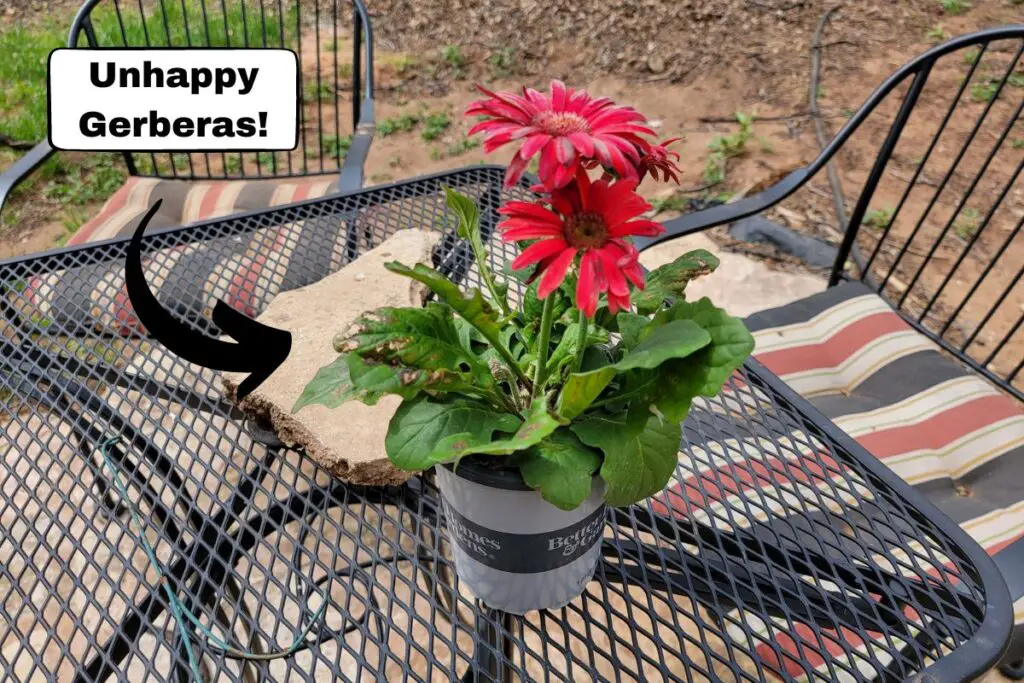Gerbera daisies are some of the most cheerful flowers that just scream “It’s finally spring!” Whether they are kept in pots or planted in the ground to overwinter and burst forth in spring, gerbera daisies bring their playful blooms to every garden they inhabit.
Table of Contents
How do I Keep My Gerbera Daisies Blooming
Keeping them blooming through their whole season requires the perfect combination of enough sun, fertilizer intended for blooming flowers, and regular moisture. To get them to stay healthy for next season, you must do some prep by deadheading your gerbera daisies.
When do Gerbera Daisies Bloom?
Depending on your zone, gerbera daisies can start their blooming as early as March. When winter is over, you will start to see little green leaves poking through the soil.
To help them along, give them a water-soluble fertilizer once they are a few inches tall. This helps feed the growing plant while it returns to life after winter’s freeze. After the leaves develop and can utilize the sun’s rays, the plant will begin to form flowers.
As the days get longer, your gerbera daisy, if it’s planted in the ground, should be receiving six to eight hours of sun per day. Too little sun stifles blooms, so if your daisy is in the shade, this is a good time to dig up the root ball and replant somewhere sunnier.
Gerbera daisies will continue to bloom throughout spring and summer with the right care. If you notice yours are not growing new flowers, there are some tips below you can follow to encourage new growth.
Should I Deadhead Gerbera Daisies?
Like many blooming flowers, gerbera daisies benefit from regular deadheading. This is the process where you use clean, sharp scissors to cut spent blooms near the base of the plant. This encourages the daisy to produce new flowers.
Make sure to sanitize your cutting equipment and take care when cutting so you don’t damage the central crown of the plant. Discard the cut flowers since if they are left around the plant, they can cause mildew and mold growth.
When trimming, you can also remove any damaged leaves to help the plant have a cleaner appearance. This is also a good chance to check on if there are any new buds forming.
Don’t pull off old blooms because you may wind up opening a tear in the crown, which can introduce fungus or bacteria.
Check out this article to learn everything you ever wanted to know about Deadheading Gerbera Daisies.
Which Fertilizer do I Use?
Flowering plants like gerbera daisies will thrive with a fertilizer formulated to help them sustain blooms. You should look for a large number in the middle of the fertilizers, like 5-20-5 or 10-30-10. These numbers indicate what elements in what ratios are in the fertilizer.
These numbers are the NPK – nitrogen, phosphorus and potassium. Each of these elements plays a vital role in plant development and health. They are also combined with trace minerals like iron to support overall plant health.
- Nitrogen is depleted by plants as they grow new leaves – that’s why many fertilizers used in spring have a higher nitrogen percentage. This helps plants get a boost when recovering from winter’s ravages.
- Phosphorus is key for blooming plants. Flowers require a lot of energy, and a fertilizer with higher amounts of phosphorus is key to helping them put on a spectacular show. Phosphorus also helps with root growth.
- Potassium is necessary for overall plant health and development. Consider this element an overall conditioner.
When fertilizing, water-soluble fertilizer is a safe bet because it is easily absorbed by the plant. Make sure not to use too much and carefully follow the label’s instructions regarding application amount and timing.
If you prefer a slow-release fertilizer, apply it around the crown of the plant and water it in. Generally, you will see faster results with water-soluble fertilizer, but you don’t need to apply granular fertilizer as often.
How Much Water do Gerbera Daisies Need?
Gerbera daisies planted outside need about an inch of water per week to thrive. That can come from rainfall, watering or a combination of those.
Do you know a cool way to measure an inch of water? Put out an empty tuna can, which is about one inch deep, near the gerbera daisy. Water with your hose, the sprinklers or leave out the can during a rainstorm to see how long it takes to fill.
Overwatering can lead to root rot, a disease where the soil is too soggy and kills the roots of the plant.
How do You Make Gerbera Daisies Rebloom?
If you are applying fertilizer regularly during the growing season, you should see consistent blooming and flowering.
Gerbera will die back to the ground every winter. This means that the only part of the plant living is the root system below ground. Generally they won’t survive a deep freeze.
However, if your winters are mild, you can wait until the plant dies back, cut the old foliage and then add several inches of mulch to insulate the roots. This will help your daisy conserve its energy for spring.
Can I Change the Color of my Gerbera Daisies?
Gerbera daisies come in many different colors. The most common are:
- Red
- Orange
- White
- Yellow
- Pink
While the strength of the colors may intensify due to fertilizer and growing conditions, you cannot change a gerbera daisy’s colors without the use of dye.
White daisies can be placed in dyed water to absorb the dye, giving you the opportunity to try fun, creative flower arrangements. Make sure to look for a floral dye and use only the amount specified.
If you are happy with the color of your gerbera daisy when it’s planted outside, make sure to regularly fertilize so the plant can keep blooming to its full potential.
Can I Grow Gerbera Daisies Indoors?
According to Miracle-Gro, gerbera daisies can be grown indoors as long as you provide good air circulation to avoid mold growth, water only when the top inch of the soil is dry and give it the correct fertilizer (calculated for blooming plants).
Indoor plants should also be given bright, indirect light and kept out of direct drafts. A daisy placed under a fan or heater will dry out, and the foliage can look dry and crisp rather than the beautiful deep green you’d associate with gerbera.
Tragically, indoor plants can suffer from an overabundance of affection – gerbera in particular. Since they are such fun flowers, family members may be compelled to overwater the plant.
You can avoid this by mixing cactus soil in with your regular potting soil. This improves drainage and gives the necessary airflow to the plant’s roots.
If your indoor gerbera is not blooming, move it where there is more sunlight or consider supplementing the light with a UV grow lamp. Flowering plants almost always need an abundance of sun, but you want to avoid scorching your indoor gerbera. Place the UV grow lamp about 12 inches above the leaves for best results.
How do I Harvest Gerbera Daisies?
One of the best parts of growing gerbera daisies is enjoying the beautiful blooms inside your home. When the blooms are the length you want, use a pair of clean, sharp scissors to cut the stem at an angle. This lets the plant absorb water more easily than a flat cut does.
Select your vase and fill with cool water. Changing the water daily will extend the life and appearance of the blooms. You should also trim the stems if they begin to brown or look soft.
Gerbera can be arranged in bundles, mixed with other flowers or added singly to a bud vase. Their bright colors ensure they will add a pop of color to any room. You can also pair them with a contrasting color to emphasize their brilliance.
What Are Some Common Pests and Problems for Gerbera Daisies?

- Wilting: This can indicate root rot or underwatering. Stick your finger in the soil near the base. If it feels dry, give the plant a deep soaking. If it feels too wet, there could be root rot. In that case, replant the plant in soil with better drainage.
- Yellow leaves: This can indicate either a lack of fertilizer or the presence of spider mites. If you see fine webbing that looks like spider web, this can tip you off. Spider mites can be removed with insecticidal soap.
- Yellow and green spots on leaves: This can indicate either a virus or bacterial leaf spot. Leaf spots can be treated with an appropriate spray, but viruses on plants cannot be treated. In that case, the plant and its surrounding soil should be removed and disposed of.
Conclusion
Your gerbera daisies can bloom all growing season, bringing a smile to your face every time you see them. Whether you choose to line your sidewalk with these colorful plants or if you pick a statement flowerpot to perfectly contrast with your yellow gerbera, giving these plants the right care ensures you’ll have an abundance of flowers to choose from. Which color will you choose?

